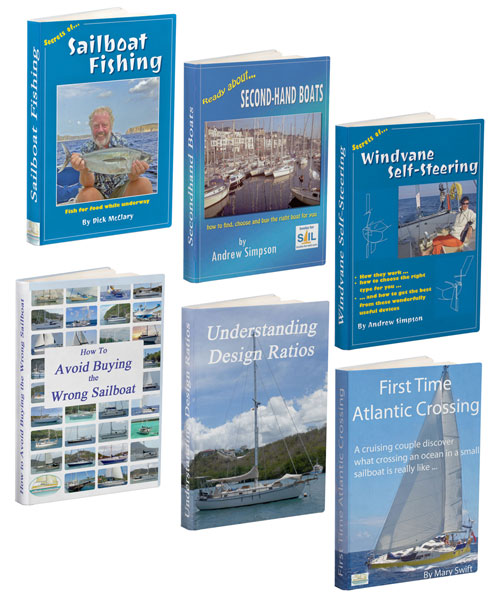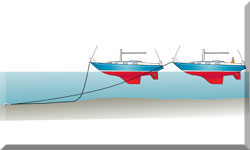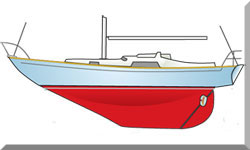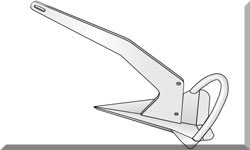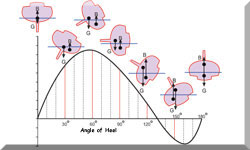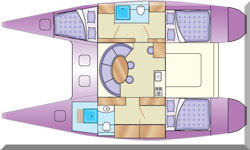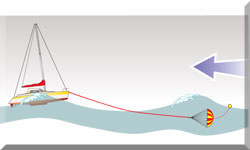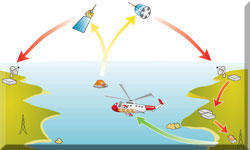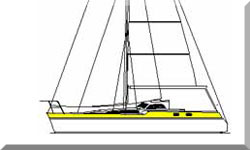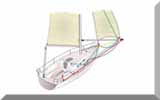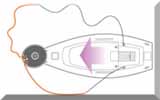- Home
- Cruising Sailboats
The Essential Features of All Good Cruising Sailboats
In a Nutshell
Choosing the ideal cruising sailboat is a journey of compromise and personal discovery. It’s not just about a boat's size or brand, but about finding a vessel that perfectly balances seaworthiness, performance, seakindliness, and cost. Ultimately, the best cruising sailboat is one that you can confidently handle, comfortably live on, and reliably maintain, allowing you to spend more time sailing and less time in the boatyard.
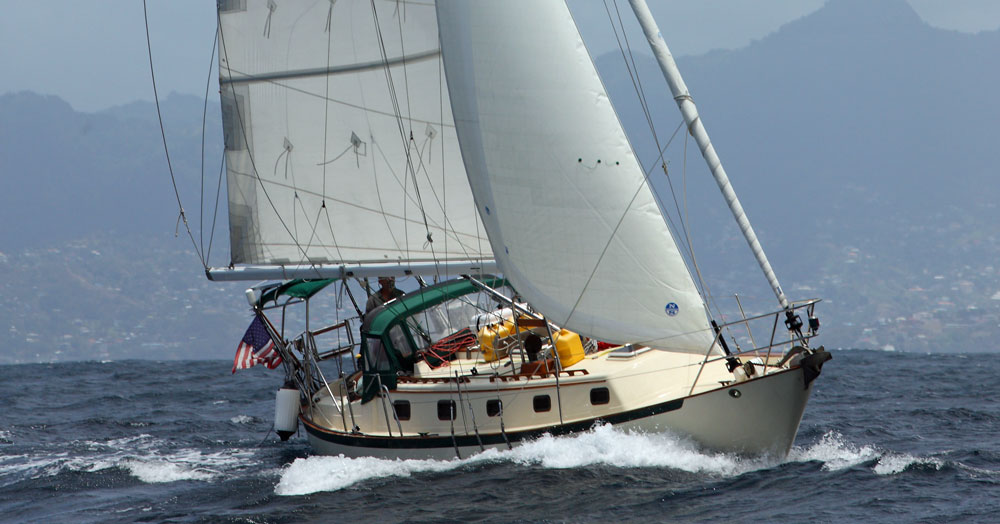 A popular and well-regarded offshore cruising sailboat, the Crealock-designed Pacific Seacraft 37
A popular and well-regarded offshore cruising sailboat, the Crealock-designed Pacific Seacraft 37Table of Contents
- The All-Important Question: What Do We Really Want?
- The Evolution of Cruising Sailboat Design
- A Deeper Look at the Cruising Sailboat's Anatomy
- The Fundamental Qualities of the Best Cruising Sailboats
- Sailing Qualities & How They Impact Your Choice
- Self-sufficiency & Essential Systems
- The Interior & The Cockpit
- Summing Up
- Frequently Asked Questions (FAQs)
You could say there are just two basic types of sailboats: cruising sailboats and racing boats. Then there are those ‘cruiser-racer’ hybrids that hover on the borderline between the two. While racing boats willingly sacrifice pretty much everything in the quest for pure speed, cruising boats have to be more of a considered compromise. They need to be robust enough for long passages, comfortable enough to live aboard, and simple enough for a small crew to manage.
For a shorthanded crew, as many cruisers are, good handling characteristics are absolutely paramount. Poor sail trim contributes greatly to poor handling, of course, but some boats just defy all attempts to get them to handle in an acceptable manner. Such tiresome vessels, despite any other wonderful attributes they may have, are the very antithesis of good cruising boats.
Beyond just handling, an offshore cruising sailboat should also have a comfortable, easy motion underway. Size, of course, has a lot going for it when it comes to sea kindliness; the bigger the sailboat, the less it will be thrown around. It’s an inescapable fact that when the sea gets up, heavier, narrow-beamed, deep-hulled offshore sailboats with longish overhangs will generally be more comfortable than beamy, flat-bottomed performance cruisers.
For a deeper look at the qualities that make a vessel truly ready for the open ocean, check out our article on Offshore Sailboat Qualities.
The All-Important Question: What Do We Really Want?
I put this question to a group of my sailing pals clustered around the bar at my local sailing club on a wet and windy October evening. Unsurprisingly, opinions were diverse. One skipper even insisted that a plumbed-in washing machine was essential on ‘proper’ cruising boats. Another felt that cruising should be closer to camping than a luxury hotel experience.
I was closer in spirit to the latter, believing that too many perceived ‘home comforts’ in sailboats can actually detract from the sailing experience. There’s a fine balance to be struck between complexity and convenience, or you'll find yourself spending a lot more time (and money) maintaining all the kit than sailing the boat.
The Evolution of Cruising Sailboat Design
If you look at the lines of a classic 1970s cruising boat next to a modern one, you’ll notice they are very different. The design of cruising sailboats has changed dramatically over the last few decades, primarily driven by new materials, technology, and a shift in what sailors expect from their boats.
In the mid-20th century, the classic design for a bluewater cruiser was a heavy displacement hull, a full keel, and a long overhang. These were boats built to handle big seas and carry momentum, making for a slower but incredibly stable and predictable ride. They were designed for the rigours of the open ocean, and their construction, often in steel or ferrocement, reflected this focus on durability over speed.
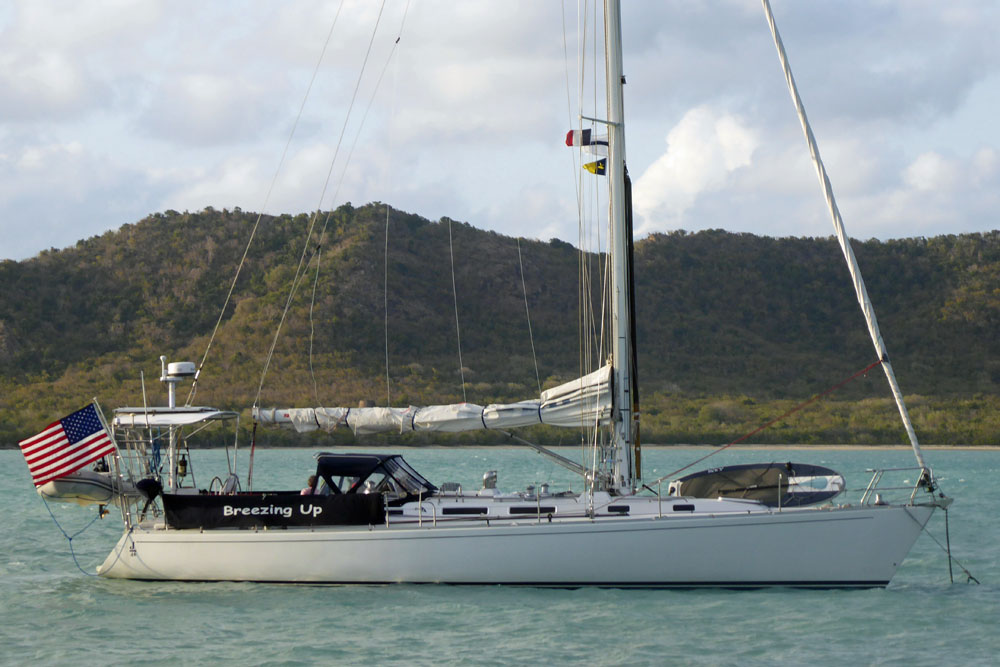 A more modern take on an offshore cruising boat, the light-displacement J-46
A more modern take on an offshore cruising boat, the light-displacement J-46Today, the trend is towards lighter, wider hulls with flatter bottoms, fin keels, and spade rudders. This evolution, pioneered by designers like Bruce Farr and Beneteau, came from a desire for more interior volume and higher performance. These boats are faster, more responsive, and more agile in light winds, but they can also be more lively in a seaway. The trade-off is a different sailing experience—one that’s less about a gentle, rolling motion and more about getting to your destination quickly.
This historical context helps explain the spirited debates you hear among sailors. It’s not just about personal preference; it's about two different philosophies of sailing and boat design.
A Deeper Look at the Cruising Sailboat's Anatomy
In our club bar discussion, all the usual arguments arose: multihull versus monohull; heavy displacement versus light displacement; centre cockpit versus aft cockpit; sloop versus ketch; tiller or wheel steering, long keel versus fin keel, and so on.
Hull material came into it too — GRP (fibreglass), ferrocement, aluminium, steel and cedar strip construction all had their passionate devotees. As did the number of hulls: monohull, catamaran or trimaran? We couldn’t even agree on the ideal interior layout or the shape and location of the cockpit, although we all agreed on the benefits of an L-shaped galley at the foot of the companionway.
This is where the real nuance of choosing a cruising sailboat comes in. Each component and design choice has a direct impact on the boat's overall character, performance, and suitability for different types of sailing. T
- Understanding Displacement: Heavy displacement hulls, like those found in older bluewater designs, offer a stable, comfortable ride in a seaway. They carry their momentum well but can be slower in light winds. Lighter displacement boats, on the other hand, are often faster and more responsive, but can feel more lively and less stable in rough seas. For more on this, check out our guide on Heavy Displacement Hulls: The Best Choice?
- Cockpit & Galley Layouts: The cockpit and galley are the heart of a cruising sailboat. The decision between a centre cockpit and an aft cockpit affects everything from visibility and security to the layout of the living quarters. Similarly, the galley’s location and layout—whether it's an L-shape, U-shape, or linear—can make a huge difference in safety and functionality at sea. For more information, read our articles on Centre vs Aft Cockpit Sailboats: A Comparison and Choosing the Best Sailboat Galley Layout.
- Steering Systems: The age-old debate of tiller versus wheel steering isn't just about personal preference. Tillers offer direct feedback from the rudder, are mechanically simple, and free up space in the cockpit. Wheels, however, provide more leverage and are often seen on larger vessels. For a detailed comparison, see our article on Tiller vs Wheel Steering: The Ultimate Guide.
The Fundamental Qualities of the Best Cruising Sailboats
So, consensus didn’t come easily, but after a heated discussion and a few more beers, we agreed that few experienced cruising sailors would argue against the following list of core requirements:
- Seaworthiness: A boat's ability to withstand severe weather and sea conditions. This includes its stability, structural integrity, and resistance to capsize.
- Seakindliness: The boat’s motion in a seaway. A seakindly boat moves gently and predictably, making for a more comfortable ride for the crew.
- Performance: A boat's speed and handling under sail. While not a racing boat, a good cruiser should be able to make respectable passage times and be responsive to the helm.
- Affordability: The total cost of ownership, including initial purchase price, maintenance, and running costs. This is a critical factor for long-term cruising.
It was clearly going to be impossible to agree on any order of precedence within this list, but after yet another beer, we did manage to condense the list into these four fundamental attributes.
Finally, we all conceded that you just can't have it all in cruising sailboats, although the deeper your pocket, the closer to it you can get.
Sailing Qualities & How They Impact Your Choice
The best cruising sailboat is one that is designed for its purpose. For an offshore sailor, that means a vessel built to handle the rigours of the open ocean. These boats often have a specific set of characteristics that distinguish them from coastal cruisers. They need to be robust, self-sufficient, and comfortable over long distances.
A few key features to look for in an offshore vessel include a sturdy rig, a well-protected cockpit, and ample storage for provisions and gear. Sailboats intended for blue water cruising, for example, are a different breed altogether. They are designed for self-sufficiency and durability over anything else. You can read more about these amazing vessels in our article, Ultimate Guide to Blue Water Sailboats.
Self-sufficiency & Essential Systems
For extended cruising, self-sufficiency is absolutely paramount. It's the difference between a trip-of-a-lifetime and a constant series of headaches. While we all love the idea of free power from the sun, we need to think bigger. A robust boat needs reliable systems to handle everything from power generation to fresh water.
- Sails & Rigging: We've already established that the sail plan and rig are fundamental to a boat's performance. The choice of sails—from the working sails for daily use to the storm sails for heavy weather—and the materials used in the rigging are crucial for both performance and safety. A well-maintained sail and rigging system is a cruiser's most important asset. For a deep dive into this topic, refer to our comprehensive articles on Sailboat Sails and Sailboat Rigging.
- Onboard Electrical Power: We all liked the idea of free power from the sun, so solar panels got everyone's approval. Windchargers also got the thumbs up, but to a lesser degree—it was the noise associated with them that marked them down. In my view, you need both, as the sun isn’t always shining, especially at night! An electric autopilot is a huge convenience, but as a huge fan of windvane self-steering gears, I would always choose this over an electric autopilot when under sail. For a detailed guide on managing your power, check out our article on Marine Electrical Systems.
- Water Tanks & Filters: A reliable supply of fresh water is non-negotiable. While many cruisers opt for a watermaker for true self-sufficiency, the importance of your water tanks and filtration system cannot be overstated. Water tanks must be made of a non-toxic material like stainless steel, food-grade plastic, or aluminium, and they must be accessible for cleaning to prevent bacterial growth. A good filtration system, ideally with both sediment and carbon filters, is essential for ensuring your water is safe to drink.
- Engine & Propeller: Let's not forget the engine. The engine, propeller, and associated systems are crucial for safety and for getting into and out of port. A reliable engine and a correctly chosen propeller are non-negotiable for a serious cruising boat. To learn more, see our article on Changing Your Sailboat Propeller. Some modern designs have even experimented with water ballast systems to improve performance and stability. While it might seem like a gimmick, a well-designed system can offer a real advantage in certain conditions. For more on this, read our article Are Water Ballast Systems Worth the Bother?
The Interior & the Cockpit
While we often focus on the hull and deck, the interior layout of a sailboat is equally crucial for long-term cruising. A well-designed cabin provides a comfortable and secure living space at sea. Some sailboat interiors, however, are not suited for offshore sailing. They may lack secure handholds, have impractical galley layouts, or offer insufficient ventilation. Read more in our article Sailboat Interiors for Offshore Sailing.
The cockpit, too, is a critical part of the boat’s design, functioning as both the nerve centre for sailing and a social hub at anchor. It must be workable for the crew and offer adequate protection from the elements. Read more about this vital area in our article on Designing the Perfect Sailboat Cockpit.
Summing Up
Choosing the right cruising sailboat is a deeply personal process that goes beyond a list of features. The best boat for you will be one that inspires confidence and joy, a vessel you can depend on, and one that fits within your budget and sailing ambitions. It's about finding that perfect blend of seaworthiness, performance, seakindliness, and cost that makes your life on the water a true pleasure. The old saying holds true: you can't have it all, but with careful consideration and a bit of experience, you can find a boat that comes pretty close.
This article was written by Dick McClary, RYA Yachtmaster and author of 'Offshore Sailing' published by the Royal Yachting Association (RYA), member of The Yachting Journalists Association (YJA), and erstwhile member of the Ocean Cruising Club (OCC).
Frequently Asked Questions (FAQs)
Q1: What’s the difference between a cruising sailboat and a racing boat?
Q1: What’s the difference between a cruising sailboat and a racing boat?
A: Racing boats are designed for maximum speed and performance, often sacrificing comfort and interior space. Cruising sailboats prioritise comfort, durability, and liveability for long-term sailing and extended passages.
Q2: Are catamarans or monohulls better for cruising?
Q2: Are catamarans or monohulls better for cruising?
A: Both have their pros and cons. Monohulls are generally more seakindly in rough seas and can be more affordable. Catamarans offer more space, stability at anchor, and often better speed off the wind, but can be more expensive to buy and berth.
Q3: What's the best hull material for a cruising sailboat?
Q3: What's the best hull material for a cruising sailboat?
A: There's no single "best" material. GRP (fibreglass) is the most common due to its low maintenance and affordability. Steel is incredibly robust and repairable, making it popular for high-latitude sailing, while aluminium is lightweight and strong but requires special care.
Q4: Should I get a long keel or a fin keel sailboat?
Q4: Should I get a long keel or a fin keel sailboat?
A: Long-keel sailboats are known for their directional stability and a comfortable motion but can be less manoeuvrable in tight spaces. Fin-keel boats are more nimble and faster to windward, but may not track as well on a long passage.
Q5: How important is self-sufficiency on a cruising boat?
Q5: How important is self-sufficiency on a cruising boat?
A: Self-sufficiency is a key consideration, especially for offshore sailing. Having your own power generation (solar, wind) and reliable steering systems (like a windvane) reduces reliance on shore power and helps you feel more secure and independent on the open water.
Resources Used
Cruising World, "The Ideal Cruising Boat", https://www.cruisingworld.com/sailboats/second-thoughts-ideal-cruising-boat/
Recent Articles
-
Mastering Offshore Seamanship: Heavy Weather & Safety Protocols
Nov 06, 25 11:43 AM
Expert guide to offshore safety and crew protocols. Master heavy weather tactics, self-steering redundancy, watchkeeping systems & essential personal safety gear. -
Tradewinds Sailing: Optimising Offshore Routes, Rigs & Comfort
Nov 06, 25 11:42 AM
Master the art of Tradewinds Sailing with expert tips on sail configurations, self-steering, and energy management for a comfortable, fast ocean passage. -
Crafting Your Offshore Passage Plan: A Step-by-Step Guide
Nov 04, 25 02:25 PM
Master your Offshore Passage Plan with our expert, four-step guide. Essential navigation insights for experienced ocean sailors, covering SOLAS & practical application.
